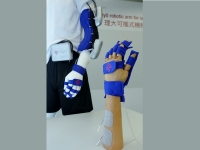Technology
PolyU Develops ROBOTIC ARM - Self-Help MOBILE REHABILITATION For STROKE PATIENTS
Lightweight Device To Exercise Anywhere

The PolyU recently developed a robotic arm (Source: The Hong Kong Polytechnic University (PolyU))
USPA NEWS -
The Hong Kong Polytechnic University (PolyU) recently developed a Robotic Arm to facilitate Self-Help and Upper-Limb Mobile Rehabilitation for Stroke Patients. The Lightweight Device enables the Patients to engage in Intensive and Effective Self-Help Rehabilitation exercise anywhere, anytime after they are discharged from Hospital. The Robotic Arm, called "Mobile Exo-Neuro-Musculo-Skeleton", is the First-Of-Its-Kind Integration of Exo-Skeleton, Soft Robot and Exo-Nerve Stimulation Technologies.
The Hong Kong Polytechnic University (PolyU) recently developed a Robotic Arm to facilitate Self-Help and Upper-Limb Mobile Rehabilitation for Stroke Patients. The Lightweight Device enables the Patients to engage in Intensive and Effective Self-Help Rehabilitation exercise anywhere, anytime after they are discharged from Hospital. The Robotic Arm, called "Mobile Exo-Neuro-Musculo-Skeleton", is the First-Of-Its-Kind Integration of Exo-Skeleton, Soft Robot and Exo-Nerve Stimulation Technologies.
Stroke is the Third Leading Cause of Disability Worldwide. In Hong Kong, there are about 25,000 New Incidences of Stroke Annually in Recent Years. Research Studies have proven that Intensive, Repeated and Long-Term Rehabilitation Training are Critical for enhancing the Physical Mobility of Stroke Patients, thus help alleviating Post-Stroke Symptoms such as Disability. However, Access to the Outpatient Rehabilitation Service for Stroke Patients has been Difficult. Due to the Overwhelming Demand for Rehabilitation Services, Patients have to queue up for a Long Time to get a Slot for Rehabilitation Training. As such, they can't gettimely Support and Routine Rehabilitation Exercises. Stroke Patients also find it challenging to travel from Home to Outpatient Clinics.
The "Mobile Exo-Neuro-Musculo-Skeleton", developed by Dr Hu Xiao-ling and her Research Team in the Department of Biomedical Engineering (BME) of PolyU, features Lightweight Design (up to 300g for Wearable Upper Limb Components, which are fit for Different Functional Training Needs), Low Power Demand (12V Rechargeable Battery Supply for 4-Hour Continuous Use), and Sportswear Features. The Robotic Arm thus provides a Flexible, Self-Help, Easy-To-Use, Mobile Tool for Patients to supplement their Rehabilitation Sessions at the Clinic. The Innovative Training Option can effectively enhance the Rehabilitation Progress.
Dr Hu Xiaoling said Development of the Novel Device was inspired by the Feedback of many Stroke Patients who were discharged from Hospital. They faced Problems in having Regular and Intensive Rehabilitation Training crucial for Limb Recovery. "We are confident that with our Mobile Exo-Neuro-Musculo-Skeleton, Stroke Patients can conduct Rehabilitation Training anytime and anywhere, turning the Training into part of their Daily Activities. We hope such Flexible Self-Help Training can well supplement Traditional Outpatient Rehabilitation Services, helping Stroke Patients achieve a much better Rehabilitation Progress." Her Team anticipated that the Robotic Arm can be commercialised in Two Years.
The BME Innovation integrates Exo-Skeleton and Soft Robot Structural Designs ; the Two Technologies commonly adopted in existing Upper-Limb Rehabilitation Training Devices for Stroke Patients as well as the PolyU-Patented Exo-Nerve Stimulation Technology.
The BME Innovation integrates Exo-Skeleton and Soft Robot Structural Designs ; the Two Technologies commonly adopted in existing Upper-Limb Rehabilitation Training Devices for Stroke Patients as well as the PolyU-Patented Exo-Nerve Stimulation Technology.
-- ) Integration of Exo-Skeleton, Soft Robot and Exo-Nerve Stimulation Technologies :
The Working Principle of both Exo-Skeleton and Soft Robot Designs is to provide External Mechanical Forces driven by Voluntary Muscle Signals to assist the Patient's desired Joint Movement. Conventional Exo-Skeleton Structure is mainly constructed by Orthotic Materials such as Metal and Plastic, simulating External Bones of the Patient. Although it is Compact in Size, it is Heavy and Uncomfortable to wear. Soft Robot, made of Air-Filled or Liquid-Filled Pipes to simulate one's External Muscles, is Light in Weight but very Bulky in Size. Both Types of structures demand High Electrical Power for Driving Motors or Pumps, thus it is not convenient for Patients to use them outside Hospitals or Rehabilitation Centres. Combining the Advantages of both Structural Designs, the BME Innovative Robotic Arm is Light in Weight, Compact in Size, Fast in Response and Demands Minimal Power Supply, therefore it is suitable for use in both Indoor and Outdoor Environment.
The Working Principle of both Exo-Skeleton and Soft Robot Designs is to provide External Mechanical Forces driven by Voluntary Muscle Signals to assist the Patient's desired Joint Movement. Conventional Exo-Skeleton Structure is mainly constructed by Orthotic Materials such as Metal and Plastic, simulating External Bones of the Patient. Although it is Compact in Size, it is Heavy and Uncomfortable to wear. Soft Robot, made of Air-Filled or Liquid-Filled Pipes to simulate one's External Muscles, is Light in Weight but very Bulky in Size. Both Types of structures demand High Electrical Power for Driving Motors or Pumps, thus it is not convenient for Patients to use them outside Hospitals or Rehabilitation Centres. Combining the Advantages of both Structural Designs, the BME Innovative Robotic Arm is Light in Weight, Compact in Size, Fast in Response and Demands Minimal Power Supply, therefore it is suitable for use in both Indoor and Outdoor Environment.
The Robotic Arm is Unique in performing Outstanding Rehabilitation Effect by further integrating the External Mechanical Force Design with the PolyU-Patented Neuro-Muscular Electrical Stimulation (NMES) Technology. Upon detecting the Electromyography Signals at the User's Muscles, the Device will respond by applying NMES to contract the Muscles, as well as exerting External Mechanical Forces to assist the Joint's Desired Voluntary Movement. Research Studies found that the Combination of Muscle Strength triggered by NMES and External Mechanical Forces is 40% more effective for Stroke Rehabilitation than applying External Mechanical Forces alone.
--- ) Rehabilitation Effect proven in Trials :
An Initial Trial of the Robotic Arm on 10 Stroke Patients indicated better Muscle Coordination, Wrist and Finger Functions, and Lower Muscle Spasticity of all after they have completed 20 Two-Hour Training Sessions. Further Clinical Trials will be carried out in Collaboration with Hospitals and Clinics.
The Robotic Arm consists of Components for Wrist/Hand, Elbow, and Fingers which can be worn separately or together for different Functional Training Needs. The Sportswear Design, using Washable Fabric with Ultraviolet Protection and Good Ventilation, also makes the Robotic Arm a comfortable Wear for the Patients.
An Initial Trial of the Robotic Arm on 10 Stroke Patients indicated better Muscle Coordination, Wrist and Finger Functions, and Lower Muscle Spasticity of all after they have completed 20 Two-Hour Training Sessions. Further Clinical Trials will be carried out in Collaboration with Hospitals and Clinics.
The Robotic Arm consists of Components for Wrist/Hand, Elbow, and Fingers which can be worn separately or together for different Functional Training Needs. The Sportswear Design, using Washable Fabric with Ultraviolet Protection and Good Ventilation, also makes the Robotic Arm a comfortable Wear for the Patients.
The Device also has a Value-Added Feature of connecting to a Mobile Application (APP) where User can use the APP Interface to control their Own Training. The APP also records Real-Time Training Data for Better Monitoring of the Rehabilitation Progress by both Healthcare Practitioners and the Patients themselves. It can also serve as a Social Network Platform for Stroke Patients to communicate Online with each other for Mutual Support.
Source : The Hong Kong Polytechnic University (PolyU)
Ruby BIRD
http://www.portfolio.uspa24.com/
Yasmina BEDDOU
http://www.yasmina-beddou.uspa24.com/
Source : The Hong Kong Polytechnic University (PolyU)
Ruby BIRD
http://www.portfolio.uspa24.com/
Yasmina BEDDOU
http://www.yasmina-beddou.uspa24.com/
Ruby Bird Yasmina Beddou Exercise Anywhere Lightweight Device Polyu Self Help Upper Limb Mobile Rehabilitation Stroke Patients
Liability for this article lies with the author, who also holds the copyright. Editorial content from USPA may be quoted on other websites as long as the quote comprises no more than 5% of the entire text, is marked as such and the source is named (via hyperlink).






